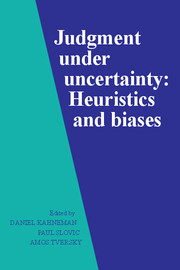Book contents
- Frontmatter
- Contents
- List of contributors
- Preface
- Part I Introduction
- Part II Representativeness
- Part III Causality and attribution
- Part IV Availability
- 11 Availability: A heuristic for judging frequency and probability
- 12 Egocentric biases in availability and attribution
- 13 The availability bias in social perception and interaction
- 14 The simulation heuristic
- Part V Covariation and control
- Part VI Overconfidence
- Part VII Multistage evaluation
- Part VIII Corrective procedures
- Part IX Risk perception
- Part X Postscript
- References
- Index
11 - Availability: A heuristic for judging frequency and probability
Published online by Cambridge University Press: 05 May 2013
- Frontmatter
- Contents
- List of contributors
- Preface
- Part I Introduction
- Part II Representativeness
- Part III Causality and attribution
- Part IV Availability
- 11 Availability: A heuristic for judging frequency and probability
- 12 Egocentric biases in availability and attribution
- 13 The availability bias in social perception and interaction
- 14 The simulation heuristic
- Part V Covariation and control
- Part VI Overconfidence
- Part VII Multistage evaluation
- Part VIII Corrective procedures
- Part IX Risk perception
- Part X Postscript
- References
- Index
Summary
Introduction
Much recent research has been concerned with the validity and consistency of frequency and probability judgments. Little is known, however, about the psychological mechanisms by which people evaluate the frequency of classes or the likelihood of events.
We propose that when faced with the difficult task of judging probability or frequency, people employ a limited number of heuristics which reduce these judgments to simpler ones. Elsewhere we have analyzed in detail one such heuristic – representativeness. By this heuristic, an event is judged probable to the extent that it represents the essential features of its parent population or generating process. …
When judging the probability of an event by representativeness, one compares the essential features of the event to those of the structure from which it originates. In this manner, one estimates probability by assessing similarity or connotative distance. Alternatively, one may estimate probability by assessing availability, or associative distance. Life-long experience has taught us that instances of large classes are recalled better and faster than instances of less frequent classes, that likely occurrences are easier to imagine than unlikely ones, and that associative connections are strengthened when two events frequently co-occur. Thus, a person could estimate the numerosity of a class, the likelihood of an event, or the frequency of co-occurrences by assessing the ease with which the relevant mental operation of retrieval, construction, or association can be carried out.
Information
- Type
- Chapter
- Information
- Judgment under UncertaintyHeuristics and Biases, pp. 163 - 178Publisher: Cambridge University PressPrint publication year: 1982
Accessibility standard: Unknown
Why this information is here
This section outlines the accessibility features of this content - including support for screen readers, full keyboard navigation and high-contrast display options. This may not be relevant for you.Accessibility Information
- 127
- Cited by
